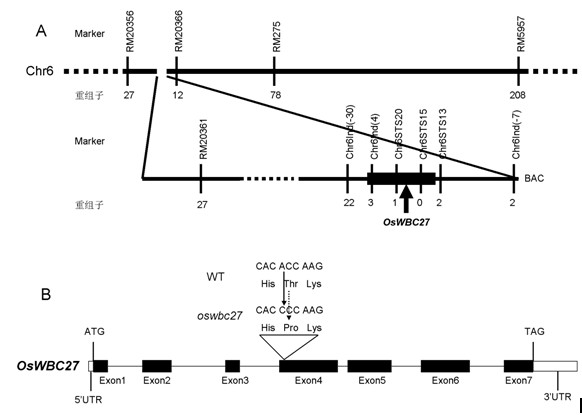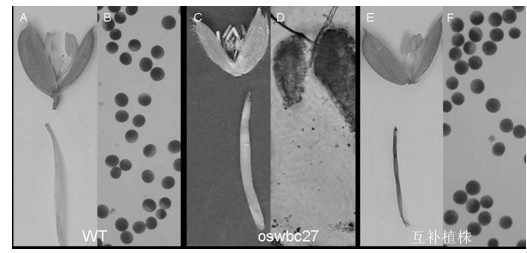Rice anther epidermis and pollen wall fat deposition gene OsABCG15, recombinant expression vector and application
An expression vector and pollen wall technology, which is applied in the field of genetic engineering, can solve the problems of limited parents, influence, and infertility of cytoplasmic-nucleus interaction sterile lines, and achieves the effect of wide application prospects.
- Summary
- Abstract
- Description
- Claims
- Application Information
AI Technical Summary
Problems solved by technology
Method used
Image
Examples
Embodiment 1
[0026] Embodiment 1, osabcg15 Obtaining Mutant Plants and Morphological Observation
[0027] Indica rice Jinhui No. 1 mutant named osabcg15 Mutants were preserved by our laboratory, using II-32B as recurrent parent, and osabcg15 The mutants were crossed and alternated backcrossed, and the mutants were finally preserved. The sterile material and II-32B were a pair of near-isogenic lines. osabcg15Mutants were crossed with II-32B, and the F1 generation was all fertile, and segregation occurred in the self-crossed F2 generation, of which 567 were normal plants and 187 were mutants, and the ratio was 3:1 (χ2 = 0.0071 osabcg15 Morphological observation of mutant plants: II-32B rice ears droop after fruiting ( figure 1 A left), while osabcg15 The mutant spikelets were not fruiting and were erect ( figure 1 A right); II-32B anther contains mature pollen and appears yellow ( figure 1 on B), osabcg15 The mutant anthers are white ( figure 1 Lower B); II-32B pollen...
Embodiment 2
[0028] Embodiment 2, OsABCG15 Gene mapping and cloning
[0029] 1. Positioning groups
[0030] Will osabcg15 The mutant was crossed with the japonica rice Nipponbare, the F2 generation was obtained by selfing, and the male sterile plants were selected as the positioning population.
[0031] 2. Extraction of rice DNA
[0032] Parents were extracted using the improved CTAB method, including the following steps: Take 0.1-0.2 grams (about half a piece) of leaves and put them in a small mortar, add an appropriate amount of liquid nitrogen, grind them to powder immediately, put them into a 2m1 centrifuge tube, and add 700μL Put the 1.5×CTAB solution preheated at 100°C in a centrifuge tube, mix it carefully, put it in a 65°C water bath, take out the centrifuge tube after 20 minutes, add an equal volume of chloroform / isoamyl alcohol, mix vigorously, centrifuge at 13000rpm for 10 minutes, and take Put the supernatant in a new tube, add 900 μL of absolute ethanol and mix well...
Embodiment 3
[0039] Embodiment 3, OsABCG15 Functional Analysis of Genes
[0040] In order to further determine OsABCG15 The gene is the gene that causes the phenotype of the male sterile mutant, from containing OsABCG15 Gene cloned from rice BAC (bacterial artificial chromosome) AP005446 OsABCG15 Gene and expression control region (comprising exons and introns of 5887bp, 1596bp upstream promoter and 1060bp downstream terminator), the nucleotide sequence is as shown in SEQ ID NO.31, digested with EcoR I and Sbf I , connected into the pCAMBIA1301 vector that was digested with the same restriction enzymes to obtain a 8.5kb pCAMBIA1301- OsABCG15 Recombinant expression vector, transform the obtained recombinant expression vector into Agrobacterium tumefaciens LBA4404 by freeze-thaw method, and obtain the recombinant expression vector pCAMBIA1301- OsABCG15 Agrobacterium tumefaciens LBA4404, named LBA4404- OsABCG15 .
[0041] The resulting LBA4404- OsABCG15 Transformed rice osabcg15 ...
PUM
 Login to View More
Login to View More Abstract
Description
Claims
Application Information
 Login to View More
Login to View More - R&D
- Intellectual Property
- Life Sciences
- Materials
- Tech Scout
- Unparalleled Data Quality
- Higher Quality Content
- 60% Fewer Hallucinations
Browse by: Latest US Patents, China's latest patents, Technical Efficacy Thesaurus, Application Domain, Technology Topic, Popular Technical Reports.
© 2025 PatSnap. All rights reserved.Legal|Privacy policy|Modern Slavery Act Transparency Statement|Sitemap|About US| Contact US: help@patsnap.com



